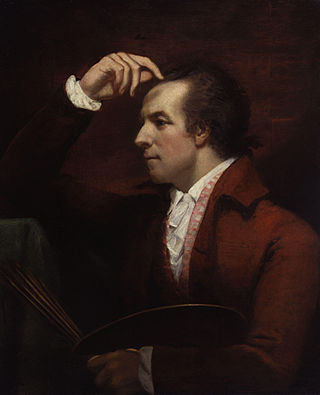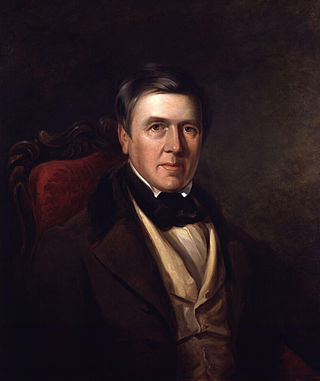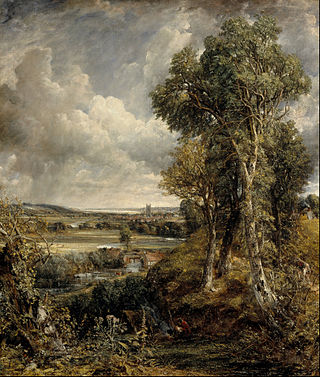
Thomas Gainsborough was an English portrait and landscape painter, draughtsman, and printmaker. Along with his rival Sir Joshua Reynolds, he is considered one of the most important British artists of the second half of the 18th century. He painted quickly, and the works of his maturity are characterised by a light palette and easy strokes. Despite being a prolific portrait painter, Gainsborough gained greater satisfaction from his landscapes. He is credited as the originator of the 18th-century British landscape school. Gainsborough was a founding member of the Royal Academy.

Joseph Mallord William Turner, known in his time as William Turner, was an English Romantic painter, printmaker and watercolourist. He is known for his expressive colouring, imaginative landscapes and turbulent, often violent marine paintings. He left behind more than 550 oil paintings, 2,000 watercolours, and 30,000 works on paper. He was championed by the leading English art critic John Ruskin from 1840, and is today regarded as having elevated landscape painting to an eminence rivalling history painting.

John Constable was an English landscape painter in the Romantic tradition. Born in Suffolk, he is known principally for revolutionising the genre of landscape painting with his pictures of Dedham Vale, the area surrounding his home – now known as "Constable Country" – which he invested with an intensity of affection. "I should paint my own places best", he wrote to his friend John Fisher in 1821, "painting is but another word for feeling".

James Northcote was a British painter. He became a member of the Royal Academy in 1787, and a member of the Royal Institute of the Netherlands in 1809.

John Trumbull was an American painter and military officer best known for his historical paintings of the American Revolutionary War, of which he was a veteran. He has been called the "Painter of the Revolution". Trumbull's Declaration of Independence (1817), one of his four paintings that hang in the United States Capitol rotunda, is used on the reverse of the current United States two-dollar bill.

David Cox was an English landscape painter, one of the most important members of the Birmingham School of landscape artists and an early precursor of Impressionism.

The Hay Wain – originally titled Landscape: Noon – is a painting by John Constable, completed in 1821, which depicts a rural scene on the River Stour between the English counties of Suffolk and Essex. It hangs in the National Gallery in London and is regarded as "Constable's most famous image" and one of the greatest and most popular English paintings.

Richard Parkes Bonington was an English Romantic landscape painter, who moved to France at the age of 14 and can also be considered as a French artist, and an intermediary bringing aspects of English style to France. Becoming, after his early death, one of the most influential British artists of his time, the facility of his style was inspired by the old masters, yet was entirely modern in its application. His landscapes were mostly of coastal scenes, with a low horizon and large sky, showing a brilliant handling of light and atmosphere. He also painted small historical cabinet paintings in a freely-handled version of the troubadour style.

The Cornfield is an oil painting by the English artist John Constable, completed from January to March 1826 in the artist’s studio. The painting shows a lane leading from East Bergholt toward Dedham, Essex, and depicts a young shepherd boy drinking from a pool in the heat of summer. The location is along Fen Lane, which the artist knew well. Constable referred to the piece as The Drinking Boy.

The Art of the United Kingdom refers to all forms of visual art in or associated with the United Kingdom since the formation of the Kingdom of Great Britain in 1707 and encompasses English art, Scottish art, Welsh art and Irish art, and forms part of Western art history. During the 18th century, Britain began to reclaim the leading place England had previously played in European art during the Middle Ages, being especially strong in portraiture and landscape art.

George Vincent was an English landscape painter who produced watercolours, etchings and oil paintings. He is considered by art historians to be one of the most talented of the Norwich School of painters, a group of artists connected by location and personal and professional relationships, who were mainly inspired by the Norfolk countryside. Vincent's work was founded on the Dutch school of landscape painting as well as the style of John Crome, also of the Norwich School. The school's reputation outside East Anglia in the 1820s was based largely upon the works of Vincent and his friend James Stark.

Frederick Richard Lee was an English artist.

Dedham is a village in the City of Colchester district of Essex, England. It is near the River Stour, which is the border of Essex and Suffolk. The nearest town to Dedham is the small market town of Manningtree.

Francis Towne was a British watercolour painter of landscapes that range from the English Lake District to Naples and Rome. After a long period of obscurity, his work has been increasingly recognised from the early 20th century onwards.

Salisbury Cathedral from the Bishop's Grounds is an 1823 landscape painting by the English landscape painter John Constable (1776–1837). This image of Salisbury Cathedral, one of England's most famous medieval churches, is one of his most celebrated works, and was commissioned by one of his closest friends, John Fisher, The Bishop of Salisbury. The 1823 version of the painting has been in the collection of the Victoria & Albert Museum in London since its bequest in 1857.

The Lock is an oil painting by English artist John Constable, finished in 1824. It depicts a rural scene on the River Stour in the English county of Suffolk, one of six paintings within the Six-Footer series. It was auctioned for £22,441,250 at Christie's in London on 3 July 2012.

The Vale of Dedham is an 1828 oil painting by the English painter John Constable which depicts Dedham Vale on the Essex-Suffolk border in eastern England. It is in the permanent collection of the Scottish National Gallery, Edinburgh.

Stratford Mill is an 1820 oil on canvas painting by the British landscape artist John Constable. It is the second painting in the series of six-footers depicting working scenes on the River Stour, a series that includes The Hay Wain. The painting is now in the collection of the National Gallery in London.

Harwich Lighthouse is an 1820 landscape painting by the British painter John Constable. It depicts a scene on the coast of Essex in England featuring Harwich Low Lighthouse. The lighthouse was maintained by Constable's patron General Rebow whose estate at Wivenhoe Park he also painted.

Gillingham Bridge is an 1823 landscape painting by the British artist John Constable. It portrays a scene of the country town of Gillingham in Dorset. It features the old bridge crossing the River Stour by the town with church tower of St Mary the Virgin in the background. Constable's friend John Fisher held the incumbency of Gillingham and Constable visited him there in 1820. He returned again in 1823 when he painted this work.




















